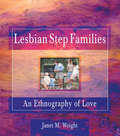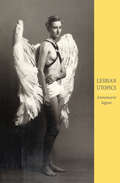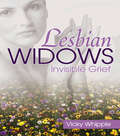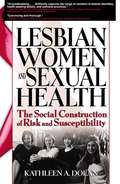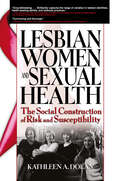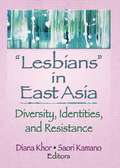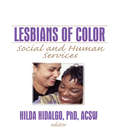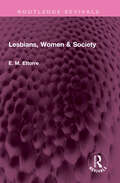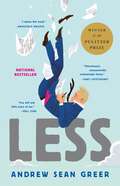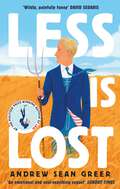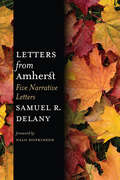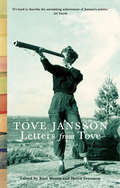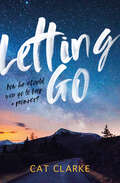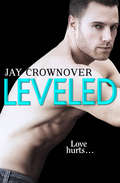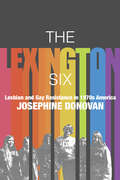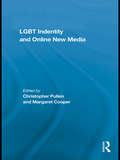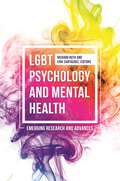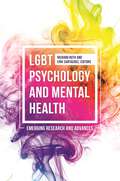- Table View
- List View
Lesbian Step Families: An Ethnography of Love
by Ellen Cole Esther D Rothblum Janet M WrightLesbian Step Families: An Ethnography of Love explores five lesbian step families’definitions of the step parent role and how they accomplish parenting tasks, cope with homophobia, and define and interpret their experiences. An intensive feminist qualitative study, the book offers guidelines for counselors and lesbian step families for creating healthy, functioning family structures and environments. It is the first book to concentrate exclusively on lesbian step families rather than on lesbian mothering in general.In Lesbian Step Families: An Ethnography of Love, you’ll explore in detail the different kinds of step relationships that are developed and what factors may lead to the different types of step mothering in lesbian step families. The book helps you understand these relationships and parent roles through in-depth discussions of: how a step mother and legal mother who live together negotiate and organize parenting and homemaking tasks how members of lesbian step families define and create the step mother role strategies family members use to define and cope with oppression how sexism is transmitted within the family and how mothering may limit and/or contribute to female liberation the opinions and viewpoints of the children of these families The findings in Lesbian Step Families: An Ethnography of Love challenge traditional views of mothering and fathering as gender and biologically based activities; they indicate that lesbian step families model gender flexibility and that the mothers and step mothers share parenting--both traditional mothering and fathering--tasks. This allows the biological mother some freedom from motherhood as well as support in it. With insight such as this, you will be prepared to help a client, a loved one, or yourself develop and maintain healthy family relationships.
Lesbian Step Families: An Ethnography of Love
by Ellen Cole Esther D Rothblum Janet M WrightLesbian Step Families: An Ethnography of Love explores five lesbian step families’definitions of the step parent role and how they accomplish parenting tasks, cope with homophobia, and define and interpret their experiences. An intensive feminist qualitative study, the book offers guidelines for counselors and lesbian step families for creating healthy, functioning family structures and environments. It is the first book to concentrate exclusively on lesbian step families rather than on lesbian mothering in general.In Lesbian Step Families: An Ethnography of Love, you’ll explore in detail the different kinds of step relationships that are developed and what factors may lead to the different types of step mothering in lesbian step families. The book helps you understand these relationships and parent roles through in-depth discussions of: how a step mother and legal mother who live together negotiate and organize parenting and homemaking tasks how members of lesbian step families define and create the step mother role strategies family members use to define and cope with oppression how sexism is transmitted within the family and how mothering may limit and/or contribute to female liberation the opinions and viewpoints of the children of these families The findings in Lesbian Step Families: An Ethnography of Love challenge traditional views of mothering and fathering as gender and biologically based activities; they indicate that lesbian step families model gender flexibility and that the mothers and step mothers share parenting--both traditional mothering and fathering--tasks. This allows the biological mother some freedom from motherhood as well as support in it. With insight such as this, you will be prepared to help a client, a loved one, or yourself develop and maintain healthy family relationships.
Lesbian Utopics
by Annamarie JagoseIn Lesbian Utopics, Annamarie Jagose surveys the construction of the lesbian and finds her in a cultural space that is both everywhere and, of all places, nowhere. The "lesbian", in other words, is symbolically central, yet culturally marginal.
Lesbian Utopics
by Annamarie JagoseIn Lesbian Utopics, Annamarie Jagose surveys the construction of the lesbian and finds her in a cultural space that is both everywhere and, of all places, nowhere. The "lesbian", in other words, is symbolically central, yet culturally marginal.
Lesbian Widows: Invisible Grief
by Victoria WhippleThe unseen issues of grief and discrimination-lesbians becoming widows The death of a life partner poses unique challenges for lesbians. Lesbian Widows: Invisible Grief reveals the touching and very personal stories of twenty-five women, including the author, who were widowed at a young age and forced to create a new life without their life partners. The book follows the widows from the time the couple met, to the time when one of the partners died, and beyond, to show how the surviving partner coped with her loss.Many lesbians feel that the intimacy felt between two women in love goes deeper than what can be experienced by heterosexual partners. Lesbian Widows: Invisible Grief reveals themes common to all these women&’s experiences while offering practical advice about coping techniques and resources for support. The widows discuss their efforts to create funerals and memorial services, give their accounts of the overwhelming grief throughout the first two years, and explain the legal and financial discrimination they encountered. The author provides a chapter specifically for caring family and friends, another chapter for professionals working with this sensitive population, and a bibliography of helpful coping resources.Lesbian Widows: Invisible Grief explores the topics of: caregivers/caretaking death and dying grief journeys the similarities and differences between lesbian and married widows the lack of support services for lesbian widows the legal and financial discrimination against lesbian widows the effect of being "in" or "out" on grief recovery the issues faced by widows in starting new relationships spirituality gay marriageLesbian Widows: Invisible Grief provides an insightful look into the grieving and recovery process, inspiring hope with the knowledge that others have survived this tragedy. This moving book is an essential resource for lesbians, friends and family of lesbians, mental health professionals, medical professionals, psychiatrists, LGBT health providers, feminist and lesbian organizations, and anyone involved with grief training programs such as hospice.
Lesbian Widows: Invisible Grief
by Victoria WhippleThe unseen issues of grief and discrimination-lesbians becoming widows The death of a life partner poses unique challenges for lesbians. Lesbian Widows: Invisible Grief reveals the touching and very personal stories of twenty-five women, including the author, who were widowed at a young age and forced to create a new life without their life partners. The book follows the widows from the time the couple met, to the time when one of the partners died, and beyond, to show how the surviving partner coped with her loss.Many lesbians feel that the intimacy felt between two women in love goes deeper than what can be experienced by heterosexual partners. Lesbian Widows: Invisible Grief reveals themes common to all these women&’s experiences while offering practical advice about coping techniques and resources for support. The widows discuss their efforts to create funerals and memorial services, give their accounts of the overwhelming grief throughout the first two years, and explain the legal and financial discrimination they encountered. The author provides a chapter specifically for caring family and friends, another chapter for professionals working with this sensitive population, and a bibliography of helpful coping resources.Lesbian Widows: Invisible Grief explores the topics of: caregivers/caretaking death and dying grief journeys the similarities and differences between lesbian and married widows the lack of support services for lesbian widows the legal and financial discrimination against lesbian widows the effect of being "in" or "out" on grief recovery the issues faced by widows in starting new relationships spirituality gay marriageLesbian Widows: Invisible Grief provides an insightful look into the grieving and recovery process, inspiring hope with the knowledge that others have survived this tragedy. This moving book is an essential resource for lesbians, friends and family of lesbians, mental health professionals, medical professionals, psychiatrists, LGBT health providers, feminist and lesbian organizations, and anyone involved with grief training programs such as hospice.
Lesbian Women and Sexual Health: The Social Construction of Risk and Susceptibility
by R Dennis Shelby Kathleen DolanInterviewer: Where did you find out how to have safe lesbian sex?Val: I found out in jail.Why do so many lesbian women engage in sexual behavior that puts their health, even their lives, at risk? Many know they&’re at risk, yet somehow feel safe enough to behave as if there is no reason to practice safe sex. Lesbian Women and Sexual Health: The Social Construction of Risk and Susceptibility examines how lesbian women perceive their level of risk for HIV and other sexually transmitted infections (STIs). It describes how their perceptions of risk and susceptibility are shaped by factors such as sexual identity, cultural themes, and community knowledge-and how those perceptions impact on the very real HIV/STI risks that lesbian women face. The genesis of Lesbian Women and Sexual Health: The Social Construction of Risk and Susceptibility lies in Kathleen Dolan&’s exploratory study of this under-researched area, in which 162 structured interviews and 70 in-depth interviews were conducted with women who self-identify as lesbians. What these women have to say will inform, educate, and probably surprise you. Tables and figures make complex data easy to access and understand.Lesbian women construct and label their identities and actions in complex ways that may lead to risky behavior. In the words of the women surveyed-and in Dr. Dolan&’s insightful commentary-this book explores the ways in which lesbian women construct their perceptions of risk and susceptibility to seek answers to questions that include: Do many lesbian women see themselves, to an extent, as immune to HIV contraction? How does their self-constructed sense of risk and susceptibility lead to making dangerous choices? Why, in spite of their professed willingness to engage in protective actions, do many lesbians not actually do so? Why do many lesbian women, and some of the health care professionals who serve them, feel that pap smears are not necessary for women who have sex only with other women-and what are the consequences of this opinion? What is the relationship between drug/alcohol use and risky sexual behaviors in lesbian women?Lesbian Women and Sexual Health: The Social Construction of Risk and Susceptibility is an important resource for women&’s/lesbian health advocates, health care professionals, and courses in gay/women&’s/medical studies. It addresses gaps in the existing research to enhance our understanding of the physical and mental health status of lesbian women, of risk factors and protective actions regarding HIV and STIs, and of the conditions for which protective actions actually reduce risk. Use it to update your knowledge of this under-studied area at the intersection of physical, emotional, and sexual health.
Lesbian Women and Sexual Health: The Social Construction of Risk and Susceptibility
by R Dennis Shelby Kathleen DolanInterviewer: Where did you find out how to have safe lesbian sex?Val: I found out in jail.Why do so many lesbian women engage in sexual behavior that puts their health, even their lives, at risk? Many know they&’re at risk, yet somehow feel safe enough to behave as if there is no reason to practice safe sex. Lesbian Women and Sexual Health: The Social Construction of Risk and Susceptibility examines how lesbian women perceive their level of risk for HIV and other sexually transmitted infections (STIs). It describes how their perceptions of risk and susceptibility are shaped by factors such as sexual identity, cultural themes, and community knowledge-and how those perceptions impact on the very real HIV/STI risks that lesbian women face. The genesis of Lesbian Women and Sexual Health: The Social Construction of Risk and Susceptibility lies in Kathleen Dolan&’s exploratory study of this under-researched area, in which 162 structured interviews and 70 in-depth interviews were conducted with women who self-identify as lesbians. What these women have to say will inform, educate, and probably surprise you. Tables and figures make complex data easy to access and understand.Lesbian women construct and label their identities and actions in complex ways that may lead to risky behavior. In the words of the women surveyed-and in Dr. Dolan&’s insightful commentary-this book explores the ways in which lesbian women construct their perceptions of risk and susceptibility to seek answers to questions that include: Do many lesbian women see themselves, to an extent, as immune to HIV contraction? How does their self-constructed sense of risk and susceptibility lead to making dangerous choices? Why, in spite of their professed willingness to engage in protective actions, do many lesbians not actually do so? Why do many lesbian women, and some of the health care professionals who serve them, feel that pap smears are not necessary for women who have sex only with other women-and what are the consequences of this opinion? What is the relationship between drug/alcohol use and risky sexual behaviors in lesbian women?Lesbian Women and Sexual Health: The Social Construction of Risk and Susceptibility is an important resource for women&’s/lesbian health advocates, health care professionals, and courses in gay/women&’s/medical studies. It addresses gaps in the existing research to enhance our understanding of the physical and mental health status of lesbian women, of risk factors and protective actions regarding HIV and STIs, and of the conditions for which protective actions actually reduce risk. Use it to update your knowledge of this under-studied area at the intersection of physical, emotional, and sexual health.
Lesbians in East Asia: Diversity, Identities, and Resistance
by Julie Garrison ADiscover the courageous, vibrant similarities and differences of lesbians in East AsiaHow are same-sex relationships similar or different in the cultures of East Asia? "Lesbians" in East Asia: Diversity, Identities, and Resistance is a unique examination of research and vital issues involving lesbians and lesbianism in East Asia, using perspectives by academics and activists who typically are rarely published in English. Contributing experts from Hong Kong, mainland China, Japan, and Korea discuss a variety of topics, including solidarity and conflicts between lesbians and feminists, identities and identity politics, lesbian lives and families, and representation in mainstream culture.Asia, because of its inherent language and cultural differences from Western society, is a location of a vast unrealized fount of knowledge about same-sex relationships and the societies in which they interact. "Lesbians" in East Asia: Diversity, Identities, and Resistance begins to fill this gap in knowledge, going beyond "East-West" divisions by gathering in one volume studies in Asia lesbian/queer studies of both the West and Asia. The text&’s emphasis is on points of connection and cooperation across the cultures within Asia and between this region and other areas of the world. Diverse viewpoints and research on lesbians in China, Hong Kong, South Korea, and Japan are presented showing issues and concerns that may be different-and often are very similar-to regions beyond those borders.Topics in "Lesbians" in East Asia: Diversity, Identities, and Resistance include: lesbian rights and feminism in Korea emotional damage suffered in family, work, and school contexts, including self-denial analysis of Internet exchanges in China, highlighting those feeling that they should maintain a low profile and others showing disdain toward the lesbian lifestyle gender inequality and discrimination and their effects on self-sufficiency the effects of expectations of marriage or remaining single on economics, legal standpoints, and in school ignorance and intolerance in Korean and Japanese societiesidentity politics conflicts of ideas between lesbians and feminists and much more! "Lesbians" in East Asia: Diversity, Identities, and Resistance is important, illuminating reading for academics and students in women&’s studies, gender studies, queer/sexuality studies, East Asian studies, and activists in feminist movements.
Lesbians in East Asia: Diversity, Identities, and Resistance
by Julie Garrison ADiscover the courageous, vibrant similarities and differences of lesbians in East AsiaHow are same-sex relationships similar or different in the cultures of East Asia? "Lesbians" in East Asia: Diversity, Identities, and Resistance is a unique examination of research and vital issues involving lesbians and lesbianism in East Asia, using perspectives by academics and activists who typically are rarely published in English. Contributing experts from Hong Kong, mainland China, Japan, and Korea discuss a variety of topics, including solidarity and conflicts between lesbians and feminists, identities and identity politics, lesbian lives and families, and representation in mainstream culture.Asia, because of its inherent language and cultural differences from Western society, is a location of a vast unrealized fount of knowledge about same-sex relationships and the societies in which they interact. "Lesbians" in East Asia: Diversity, Identities, and Resistance begins to fill this gap in knowledge, going beyond "East-West" divisions by gathering in one volume studies in Asia lesbian/queer studies of both the West and Asia. The text&’s emphasis is on points of connection and cooperation across the cultures within Asia and between this region and other areas of the world. Diverse viewpoints and research on lesbians in China, Hong Kong, South Korea, and Japan are presented showing issues and concerns that may be different-and often are very similar-to regions beyond those borders.Topics in "Lesbians" in East Asia: Diversity, Identities, and Resistance include: lesbian rights and feminism in Korea emotional damage suffered in family, work, and school contexts, including self-denial analysis of Internet exchanges in China, highlighting those feeling that they should maintain a low profile and others showing disdain toward the lesbian lifestyle gender inequality and discrimination and their effects on self-sufficiency the effects of expectations of marriage or remaining single on economics, legal standpoints, and in school ignorance and intolerance in Korean and Japanese societiesidentity politics conflicts of ideas between lesbians and feminists and much more! "Lesbians" in East Asia: Diversity, Identities, and Resistance is important, illuminating reading for academics and students in women&’s studies, gender studies, queer/sexuality studies, East Asian studies, and activists in feminist movements.
Lesbians of Color: Social and Human Services
by Hilda HidalgoBroaden your understanding of lesbians of color, their perspectives, and their needs from a human services point of view. Lesbians of Color: Social and Human Services helps you understand the ways in which lesbians of color perceive important issues related to their oppression and discrimination by the dominant social service community. The authors’personalized accounts graphically depict the deep-seated impacts of society’s racism, sexism, and homophobia. This insightful book suggests effective ways of changing detrimental practices and agency policies that perpetuate oppression and discrimination, and it enhances your interactions with lesbians of color. Chapters build on “feminist standpoint theory,” a theory of inquiry enlightened by authors’firsthand knowledge that helps you move from an intellectual to an empathic grasp of the points made by each author. The use of standpoint theory gives you a different way of gaining insight and understanding of the experiences of lesbians of color. It acts as a springboard for valuing and celebrating the experiences and perspectives of lesbians of color so you can, in turn, provide more sensitive and effective services to members of this population. Among the topics explored in Lesbians of Color are: specific ways white practitioners should behave to demonstrate their sensitivity and respect for lesbians of color insight as to how “need perceptions” and “problem diagnosis” varies when the practitioner listens to and understands lesbians of color specific identity issues that affect the emotional well-being of adopted lesbians visibility and activism as contributors to the mental health of lesbians of color how visibility and activism are essential in creating positive changes in policies and practices for lesbians of colorThis volume is useful for professionals involved in direct service practice with lesbian clients and for administrators of social service agencies. The book is also a helpful guide for educators in professional preparation programs who must introduce students to issues related to lesbians of color.
Lesbians of Color: Social and Human Services
by Hilda HidalgoBroaden your understanding of lesbians of color, their perspectives, and their needs from a human services point of view. Lesbians of Color: Social and Human Services helps you understand the ways in which lesbians of color perceive important issues related to their oppression and discrimination by the dominant social service community. The authors’personalized accounts graphically depict the deep-seated impacts of society’s racism, sexism, and homophobia. This insightful book suggests effective ways of changing detrimental practices and agency policies that perpetuate oppression and discrimination, and it enhances your interactions with lesbians of color. Chapters build on “feminist standpoint theory,” a theory of inquiry enlightened by authors’firsthand knowledge that helps you move from an intellectual to an empathic grasp of the points made by each author. The use of standpoint theory gives you a different way of gaining insight and understanding of the experiences of lesbians of color. It acts as a springboard for valuing and celebrating the experiences and perspectives of lesbians of color so you can, in turn, provide more sensitive and effective services to members of this population. Among the topics explored in Lesbians of Color are: specific ways white practitioners should behave to demonstrate their sensitivity and respect for lesbians of color insight as to how “need perceptions” and “problem diagnosis” varies when the practitioner listens to and understands lesbians of color specific identity issues that affect the emotional well-being of adopted lesbians visibility and activism as contributors to the mental health of lesbians of color how visibility and activism are essential in creating positive changes in policies and practices for lesbians of colorThis volume is useful for professionals involved in direct service practice with lesbian clients and for administrators of social service agencies. The book is also a helpful guide for educators in professional preparation programs who must introduce students to issues related to lesbians of color.
Lesbians, Women & Society (Routledge Revivals)
by E M EttorreFirst published in 1980, Lesbians, Women and Society presents an analysis of lesbianism as a phenomenon that developed from a ‘personal problem’ or ‘individual deviance’ to a social movement with political ambitions. Social lesbianism, an important concept introduced in the text, refers to the emergence of a public expression of lesbianism and is a stage in the process of establishing a lesbian group identity. It thrusts the issue into the public eye, and lends vitality to society’s awareness. Two groups of ‘social lesbians’ are visible: those fearful of change who cling to traditional and social views, ‘sick but not sorry’; and those who wish to challenge such traditional views in favour of a more public approach, ‘sorry, but we’re not sick.’ But regardless of their relationships to the dominant sexual ideology, as a group, ‘social lesbians’ threaten the structure of power in society. This critical analysis thus challenges many people’s views of lesbianism, and points out to the uninformed observer the complexities which are involved in the contemporary lesbian experience. This book will be of interest to students of sociology, gender studies, feminist theory, and sexuality studies.
Lesbians, Women & Society (Routledge Revivals)
by E M EttorreFirst published in 1980, Lesbians, Women and Society presents an analysis of lesbianism as a phenomenon that developed from a ‘personal problem’ or ‘individual deviance’ to a social movement with political ambitions. Social lesbianism, an important concept introduced in the text, refers to the emergence of a public expression of lesbianism and is a stage in the process of establishing a lesbian group identity. It thrusts the issue into the public eye, and lends vitality to society’s awareness. Two groups of ‘social lesbians’ are visible: those fearful of change who cling to traditional and social views, ‘sick but not sorry’; and those who wish to challenge such traditional views in favour of a more public approach, ‘sorry, but we’re not sick.’ But regardless of their relationships to the dominant sexual ideology, as a group, ‘social lesbians’ threaten the structure of power in society. This critical analysis thus challenges many people’s views of lesbianism, and points out to the uninformed observer the complexities which are involved in the contemporary lesbian experience. This book will be of interest to students of sociology, gender studies, feminist theory, and sexuality studies.
Less: Winner of the Pulitzer Prize for Fiction 2018 (An Arthur Less Novel)
by Andrew Sean GreerWINNER OF THE PULITZER PRIZE FOR FICTION 2018 'You will sob little tears of joy' Nell Zink'I recommend it with my whole heart' Ann Patchett'I adore this book' Armistead Maupin'Charming, languid and incredibly funny, I absolutely adored Arthur' Jenny Colgan 'Marvellously, endearingly, unexpectedly funny' Gary Shteyngart'Bedazzling, bewitching and be-wonderful' New York Times Book Review'A fast and rocketing read . . . a wonderful, wonderful book!' Karen Joy Fowler'Hilarious, and wise, and abundantly funny' Adam Haslett'Ideal for holiday reading' The Lady WHO SAYS YOU CAN'T RUN AWAY FROM YOUR PROBLEMS?Arthur Less is a failed novelist about to turn fifty. A wedding invitation arrives in the post: it is from an ex-boyfriend of nine years who is engaged to someone else. Arthur can't say yes - it would be too awkward; he can't say no - it would look like defeat. So, he begins to accept the invitations on his desk to half-baked literary events around the world. From France to India, Germany to Japan, Arthur almost falls in love, almost falls to his death, and puts miles between him and the plight he refuses to face. Less is a novel about mishaps, misunderstandings and the depths of the human heart.
Less is Lost: 'An emotional and soul-searching sequel' (Sunday Times) to the bestselling, Pulitzer Prize-winning Less (An Arthur Less Novel)
by Andrew Sean GreerThe awkward and lovable hero of Andrew Sean Greer's bestselling and prize-winning novel Less returns in this unforgettable road trip across America. 'Wildly, painfully funny' David Sedaris'Unforgettable' Elizabeth Day'The joyfulness of this book is a balm' Madeline Miller'What a joy' Katie KitamuraFor Arthur Less, life is going surprisingly well: he is a moderately accomplished novelist in a steady relationship with his partner, Freddy Pelu. But nothing lasts: the death of an old lover and a sudden financial crisis has Less running away from his problems yet again as he accepts a series of literary gigs that send him on a zigzagging adventure across the US.Less roves across the 'Mild Mild West', through the South and to his mid-Atlantic birthplace, with an ever-changing posse of writerly characters and his trusty duo - a human-like black pug, Dolly, and a rusty camper van nicknamed Rosina. He grows a handlebar mustache, ditches his signature gray suit, and disguises himself in the bolero-and-cowboy-hat costume of a true 'Unitedstatesian'... with varying levels of success, as he continues to be mistaken for either a Dutchman, the wrong writer, or, worst of all, a 'bad gay'.We cannot, however, escape ourselves - even across deserts, bayous, and coastlines. From his estranged father and strained relationship with Freddy, to the reckoning he experiences in confronting his privilege, Arthur Less must eventually face his personal demons. With all of the irrepressible wit and musicality that made Less a bestselling, Pulitzer Prize-winning, must-read breakout book, Less Is Lost is a profound and joyous novel about the enigma of life, the riddle of love, and the stories we tell along the way.
Letters from Amherst: Five Narrative Letters
by Samuel R. DelanyFive substantial letters written from 1989 to 1991 bring readers into conversation with Hugo and Nebula Award winning-author Samuel Delany. With engaging prose, Delany shares details about his work, his relationships, and the thoughts he had while living in Amherst and teaching as a professor at the UMASS campus just outside of town, in contrast to the more chaotic life of New York City. Along with commentary on his own work and the work of other writers, he ponders the state of America, discusses friends who are facing AIDS and other ailments, and comments on the politics of working in academia. Two of the letters, which tell the story of his meeting his life partner Dennis, became the basis of his 1995 graphic novel, Bread & Wine. Another letter describes the funeral of his uncle Hubert T. Delany, former judge and well-known civil rights activist, and leads to reflections on his family's life in 1950s Harlem. Another details a visit from science fiction writer and critic Judith Merril, and in another he gives a portrait of his one-time student Octavia E. Butler, who by then has become his colleague. In addition, an appendix shares ten letters Delany sent to his daughter while she attended summer camp between 1984 and 1988. These letters describe Delany's daily life, including visitors to his upper-west-side apartment, his travels for work and pleasure, lectures attended, movies viewed, and exhibits seen.
Letters from Tove
by Tove JanssonOut of the thousands of letters Tove Jansson wrote, a cache remains that she addressed to her family, her closest confidantes and her lovers – both male and female. Into these letters she spilled her innermost thoughts, defended her ideals and revealed her heart. To read them is an act of startling intimacy and a rare privilege. Offering a personal narrative that is far more revealing than any autobiography, this is Tove Jansson writing in her own words and in her own time about her life as it unfolded in Helsinki’s bohemian circles and the island refuge she shared with her partner, Tuulikki Pietilä.
Letting Go
by null Cat ClarkeA thoughtful and moving novella of love, loss and learning when to let go, from the YA ‘queen of emotional suspense’ Cat Clarke. When Agnes made a promise to her girlfriend Ellie, she thought they would be together forever. One year later, Agnes is keeping that promise and it's put her in a situation she never could have predicted; climbing a desolate mountain, in miserable weather, with Ellie and her new boyfriend Steve. But when the weather takes a threatening turn and the sky-high tension between the trio hits its peak, Agnes will have to push herself further than she ever thought was possible…A gripping and moving story of love, loss and finding yourself from an award-winning YA author. Particularly suitable for struggling, reluctant or dyslexic readers aged 14+
The Lexington Six: Lesbian and Gay Resistance in 1970s America
by Josephine DonovanOn September 23, 1970, a group of antiwar activists staged a robbery at a bank in Massachusetts, during which a police officer was killed. While the three men who participated in the robbery were soon apprehended, two women escaped and became fugitives on the FBI's Ten Most Wanted list, eventually landing in a lesbian collective in Lexington, Kentucky, during the summer of 1974. In pursuit, the FBI launched a massive dragnet. Five lesbian women and one gay man ended up in jail for refusing to cooperate with federal officials, whom they saw as invading their lives and community. Dubbed the Lexington Six, the group's resistance attracted national attention, inspiring a nationwide movement in other minority communities. Like the iconic Stonewall demonstrations, this gripping story of spirited defiance has special resonance in today's America. Drawing on transcripts of the judicial hearings, contemporaneous newspaper accounts, hundreds of pages of FBI files released to the author under the Freedom of Information Act, and interviews with many of the participants, Josephine Donovan reconstructs this fascinating, untold story. The Lexington Six is a vital addition to LGBTQ, feminist, and radical American history.
LGBT Identity and Online New Media
by Christopher PullenLGBT Identity and Online New Media examines constructions of LGBT identity within new media. The contributors consider the effects, issues, influences, benefits and disadvantages of these new media phenomena with respect to the construction of LGBT identities. A wide range of mainstream and independent new media are analyzed, including MySpace, Facebook, YouTube, gay men’s health websites, message boards, and Craigslist ads, among others. This is a pioneering interdisciplinary collection that is essential reading for anyone interested in the intersections of gender, sexuality, and technology.
LGBT Identity and Online New Media
by Christopher Pullen Margaret CooperLGBT Identity and Online New Media examines constructions of LGBT identity within new media. The contributors consider the effects, issues, influences, benefits and disadvantages of these new media phenomena with respect to the construction of LGBT identities. A wide range of mainstream and independent new media are analyzed, including MySpace, Facebook, YouTube, gay men’s health websites, message boards, and Craigslist ads, among others. This is a pioneering interdisciplinary collection that is essential reading for anyone interested in the intersections of gender, sexuality, and technology.
LGBT Psychology and Mental Health: Emerging Research and Advances (Practical and Applied Psychology)
by Richard Ruth and Erik SantacruzThis cutting-edge guide spotlights some of the most exciting emerging discoveries, trends, and research areas in LGBT psychology, both in science and therapy.LGBT Psychology and Mental Health: Emerging Research and Advances brings together concise, substantive reviews of what is new or on the horizon in science and in key areas of clinical practice. It will equip professionals at institutions with mental health programs that deal with lesbian, gay, bisexual and transgender issues with information and insight to help psychologists, mental health clinicians, and counselors better serve the LGBT populations that, increasingly, are seeking their services.The book begins with introductory chapters that present an overview of the field, chronicle the relationship between the LGBT community and the field of psychology in past decades, and identify emerging issues covered in the volume. It then addresses subjects such as social psychology and LGBT populations, health disparities and LGBT populations, the evolution of developmental theory related to the LBGT populations, emerging policy issues in LGBT health and psychology, and recent efforts to make the field of psychology more trans-inclusive and affirmative. Chapters are also dedicated to examining contemporary, LGBT-affirmative psychoanalysis and treating addictions and substance abuse in the LGBT community. The book concludes with chapters that address how the concept of intersectionality can serve as a way to better understand LGBT members who possess multiple cultural identities and the unique stressors they experience in daily life. The final chapter summarizes issues that bridge the contributions provided by the authors, and it highlights current issues of focal concern in order to project future directions for the field of LGBT psychology in the next two decades.
LGBT Psychology and Mental Health: Emerging Research and Advances (Practical and Applied Psychology)
by Richard Ruth Erik SantacruzThis cutting-edge guide spotlights some of the most exciting emerging discoveries, trends, and research areas in LGBT psychology, both in science and therapy.LGBT Psychology and Mental Health: Emerging Research and Advances brings together concise, substantive reviews of what is new or on the horizon in science and in key areas of clinical practice. It will equip professionals at institutions with mental health programs that deal with lesbian, gay, bisexual and transgender issues with information and insight to help psychologists, mental health clinicians, and counselors better serve the LGBT populations that, increasingly, are seeking their services.The book begins with introductory chapters that present an overview of the field, chronicle the relationship between the LGBT community and the field of psychology in past decades, and identify emerging issues covered in the volume. It then addresses subjects such as social psychology and LGBT populations, health disparities and LGBT populations, the evolution of developmental theory related to the LBGT populations, emerging policy issues in LGBT health and psychology, and recent efforts to make the field of psychology more trans-inclusive and affirmative. Chapters are also dedicated to examining contemporary, LGBT-affirmative psychoanalysis and treating addictions and substance abuse in the LGBT community. The book concludes with chapters that address how the concept of intersectionality can serve as a way to better understand LGBT members who possess multiple cultural identities and the unique stressors they experience in daily life. The final chapter summarizes issues that bridge the contributions provided by the authors, and it highlights current issues of focal concern in order to project future directions for the field of LGBT psychology in the next two decades.
